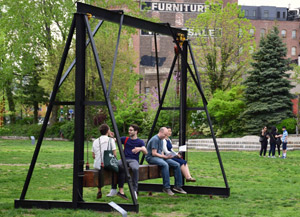3.7.25 — From Song into Space
Polonius: Will you walk out of the air, my lord?
The prince: Into my grave?
—Hamlet 2:2
Twenty years ago, on entering his fifties, Ralph Lemon gave up quite a career in dance. He had left the Meredith Monk dance company in 1985 to found his own, but that, too, was no longer enough. Maybe he was sick of telling others what to do.
While he had continued to dance for Alvin Ailey and others, he had always loved choreography as an art of collaboration—and any musical theater as mixed media, mixed influences, and sheer mania. He could fulfill that only in what he liked to call No Dance, meaning performance. And now he takes that history to MoMA PS1 as “Ceremonies out of the Air,” through March 24.
 Some reaching so monumental a decision would say they never look back. Lemon always looked back. He had made a point of injecting politics and history into his work, ever since co-founding the Mixed Blood Theater Company in 1976. He calls one work The Greatest (Black) History Ever Told, with his usual mix of ambition, irony, sincerity, and a gentle sense of humor directed first and foremost at himself. He looks back in a collage to a rural kitchen, where folks wear animal masks to tackle a half-eaten plate of pancakes and an untouched whole pineapple. He calls another piece, of half-length sculpture, his Consecration of Ancestor Figures.
Some reaching so monumental a decision would say they never look back. Lemon always looked back. He had made a point of injecting politics and history into his work, ever since co-founding the Mixed Blood Theater Company in 1976. He calls one work The Greatest (Black) History Ever Told, with his usual mix of ambition, irony, sincerity, and a gentle sense of humor directed first and foremost at himself. He looks back in a collage to a rural kitchen, where folks wear animal masks to tackle a half-eaten plate of pancakes and an untouched whole pineapple. He calls another piece, of half-length sculpture, his Consecration of Ancestor Figures.
If the collage is only a footnote to performance, performers elsewhere wear masks, too. It is his Rant (Redux), a raunchy and contemporary but still totemic song and dance. The title may refer to its recreation of a piece from 2000, but then what comes around goes around for Lemon, and he embellishes it further with Rant Residuum. They make a nice welcoming act to the exhibition, on four-channel video that gives a sense of performance in close-up, by Kevin Beasley and others, but also theater in the round, with the audience on camera, too. The singers are black and the song is black popular music, but the audience is both black and white—or maybe, as Lemon sometimes says, “blackified.” Recent paintings are a collage of mixed culture, but also a look back at his own past work.
They are a look back, too, to his first love in art, painting, which continues with sheer abstraction, of circles embedded in the cells of a suitably sloppy grid. This is the world of his ancestors, but also of art, and that breakfast takes place across from an actual table of aluminum and black steel, set with unappetizing sculpture and draped below with electric lights. Lemon tackles the remains of Minimalism and performance, too, in FBN—where BN is Bruce Nauman, and F is a four-letter word. The floor piece looks more like a gravestone than a celebration. At whom is the irony directed this time? You can judge for yourself.
Meanwhile, in still another video act, Lemon goes about his business of “harvesting” string. He may always be harvesting whatever he can toward whatever strikes his fancy. James Baldwin turns up in animation, barely blinking an eye. Yet the cast is rich, past and present, human and animal, and just one more thing as well. He finds his oldest collaborator on a final mission into space. Its videos take three rooms apart from the main display of his work, but he knows he has a long way to go.
This is his Walter Carter Suite, where Carter, born in 1907, was perhaps the last surviving sharecropper. The old man can collaborate on a spaceship regardless, although Lemon does the bulk of the work—and Carter, he seems to say, has better things to do than dwell on a painful history. If the human race is to endure, it, too, will have to transform that history into an improbable future. He is already listening, too, for extraterrestrials, with an antenna dish on top. In case you were worried, the ship also doubles as a doghouse. The completed ship on display in the gallery (or maybe another version of it) lacks both the dish and a dog, but it is only a work of art.
How silly is this? It becomes poignant all the same, as one of the two old men lies asleep or inert on rumpled sheets, with an old woman watching over him. (Lemon is now seventy-two.) He could be dead or dying, but in time he gets up, grabs the gun by his side, and leaves. He might have departed for this world or another. Unless, that is, one world is just the other redux.
Read more, now in a feature-length article on this site.

